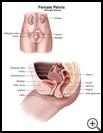
Chlamydial Infection in Females: Teen Version
________________________________________________________________________
KEY POINTS
- Chlamydia is a sexually transmitted disease or infection (STD or STI) that often has no symptoms. It usually affects the urinary tract and female organs. Infection with chlamydia can cause infertility, which means you will be unable to get pregnant or will need medical help to get pregnant.
- You will be treated with antibiotic medicine. Your infection will be reported to the local health department confidentially, so your sexual partners can be told that they have had contact with someone who has a sexually transmitted infection.
- To prevent a chlamydia infection and other STDs, always use latex or polyurethane condoms during foreplay and every time you have vaginal, oral, or anal sex.
________________________________________________________________________
What is chlamydial infection?
Chlamydia is a common sexually transmitted disease or infection (also called an STD or STI).
The infection can affect many parts of the body. The infection is often in the urinary tract and female organs. It’s important to find and treat chlamydia because it can cause painful infection and scarring of the female organs. It can cause infertility, which means you will be unable to get pregnant or will need medical help to get pregnant. The risk is greatest if you have an infection for weeks or months without treatment. Also, if you have chlamydia and then have unsafe sex with someone who has HIV, you are more likely to be infected with HIV.
What is the cause?
The infection is caused by bacteria called chlamydia. It is usually passed from person to person during oral, vaginal, or anal sex. The infection can pass from a pregnant woman to her baby during birth. Chlamydia can cause eye infections or pneumonia in the baby.
What are the symptoms?
Most people who are infected do not have any symptoms. This means you could pass the infection to your sexual partner without knowing that you are infected. Also, your partner can pass the infection to you without having any symptoms.
Symptoms may include:
- Thick, creamy, yellow discharge from the vagina
- Mild pain or discomfort when you urinate
- Menstrual periods that are heavier or more painful than usual
- Pain in your belly, especially during sex
- Spotting between periods or after sex
- Irritation around the anus
- Pain when you have a bowel movement
- Sore throat if your throat gets infected with chlamydia
How is it diagnosed?
Your healthcare provider will ask about your symptoms and sexual and medical history and examine you. Tests may include:
- Urine test
- Pelvic exam
- Swab for a test sample from your cervix (the lower part of the uterus that opens into the vagina) during a pelvic exam
Healthcare providers recommend yearly tests for chlamydia in sexually active teens and young women up to age 25.
How is it treated?
Chlamydia is treated with antibiotic medicine. You may need to take more than 1 antibiotic.
If the infection has spread into your female organs, including the uterus, ovaries, and Fallopian tubes, and you are very sick, you may need antibiotic treatment in the hospital for a few days.
Be sure to tell your healthcare provider if you are or may be pregnant. Your provider will choose an antibiotic that is safe for your unborn baby.
You will be asked about your sexual partners. Your infection will be reported to the local health department and your sexual partners will be told that they have had contact with someone who has a sexually transmitted infection. Your name will not be given. This will help them get prompt treatment for the infection. It can also help prevent new infections.
Ask your healthcare provider if you should get checked again after treatment to make sure the infection is gone.
How can I take care of myself?
- Take your medicine for as long as your healthcare provider prescribes, even if you feel better. If you stop taking an antibiotic too soon, you may not kill all of the bacteria and you may get sick again.
- Take nonprescription pain medicine if needed.
- Tell everyone with whom you have had sex in the last 3 months about your infection. Or you can ask the clinic staff to tell them without using your name. Your sexual contacts need to be treated even if they don’t have any symptoms.
- Don’t have sex until both you and your partner have finished all of the medicine and your provider says it’s OK.
- Have a checkup every year. See your provider between checkups if you are having symptoms of vaginal infection or discomfort, especially up in the abdomen, during sex.
- Ask your healthcare provider:
- How and when you will get your test results
- What other STDs you should be tested for
- How long it will take to recover
- If there are activities you should avoid and when you can return to normal activities
- When it is safe to have sex again
- How to take care of yourself at home
- What symptoms or problems you should watch for and what to do if you have them
- Make sure you know when you should come back for a checkup. Keep all appointments for provider visits or tests.
How can I help prevent chlamydial infection?
- Use latex or polyurethane condoms during foreplay and every time you have vaginal, oral, or anal sex.
- Have just 1 sexual partner who is not sexually active with anyone else.
- If you had sex and are worried that you may be infected, see your healthcare provider even if you don’t have symptoms.
- If you are pregnant, ask your healthcare provider to test you for chlamydia so you can help prevent infection in the baby.
Last modified: 2018-01-29
Last reviewed: 2018-01-08

